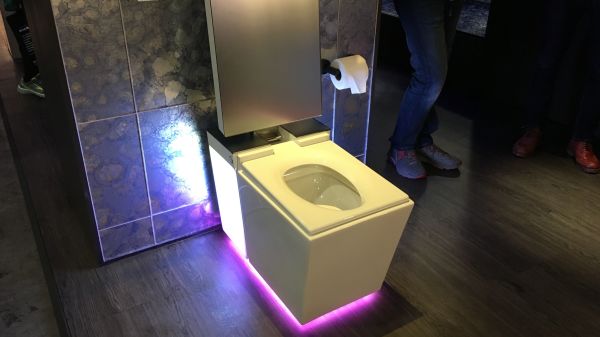 Before I even got home from Las Vegas late Friday afternoon, I was already being pelted with the oft-asked question:
Before I even got home from Las Vegas late Friday afternoon, I was already being pelted with the oft-asked question:
“So, what was the hottest gadget you saw at CES?”
And that used to be the right way to think about the world’s largest tech show. Thinking back over my 10 years in attendance at CES, there was often an obvious theme or killer gadget that dominated the show. From netbooks (remember them?) to tablets to smart speakers to autonomous cars to smart watches, there were many years when a single piece of technology ran through the Las Vegas Convention Center like a lightning bolt.
Not so much in the past few years. Tech writer Lance Ulanoff referred to CES 2019 as an “off year,” pointing out that most of this year’s so-called “innovations” – robots, roll-up TVs, smart locks – were all around last year. Or the year before.
Somehow, Lance missed the smart toilet (pictured above), a standout gadget by Kohler that retails for as much as $7,000. But what amazing features it has!
I’ve learned that these past few years at CES, it’s been less about that one breakthrough innovation, and more about the confluence of all this technology, and what it means to our lives and the workplace.
At our CES Tour dinner Wednesday night with our partners at RAB, former Chief Economist at the Consumer Technology Association and 0ne of our brilliant tour guides, Shawn DuBravac, referred to CES not as a tech show, but as a business show.
One reason why there was no “one big thing” at CES is that we’ve reached a near-saturation point in ownership of TVs, smartphones, and laptops. In fact, Marketing Charts heralds a Consumer Technology research study conducted last that reveals that for this first time, they’re now the top three gadgets in Americans’ homes.
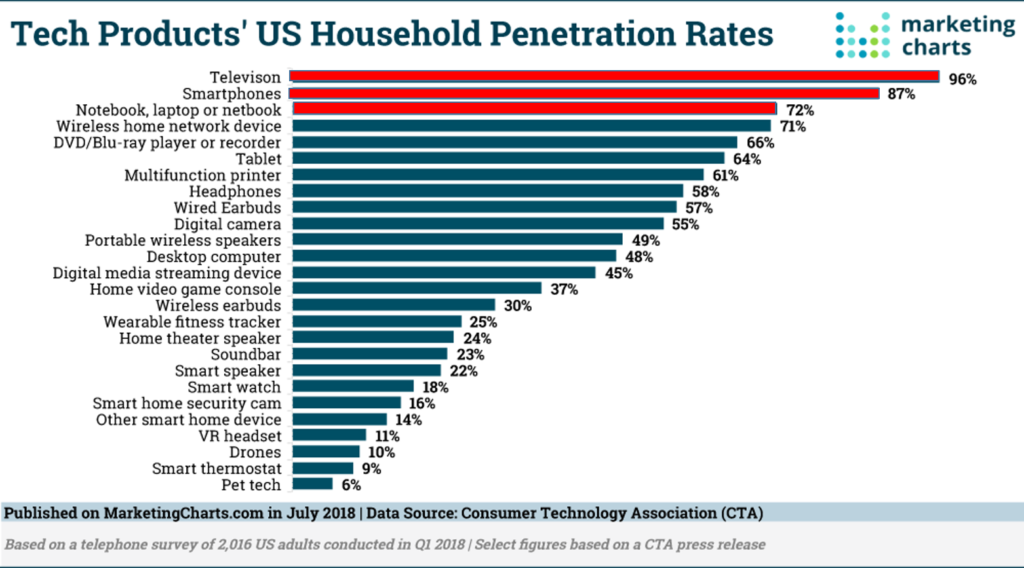
And while there were folding smartphones and 88″ 8K OLED TVs floating around the LVCC, we’ve seen this stuff before. As Apple has learned the hard way, it gets more difficult to successfully improve gadgets that are already pretty damn good. That’s been the case for iPhone and iPads, where consumers are hanging on to their old devices because they still function well, and are loaded with useful features. Their newer versions are improved…but not by all that much.
The bigger story at CES has to do with the ways in which technologies we’ve been getting accustomed to are now coming together – meshing like gears. The confluence of many different tech verticals is becoming more obvious as they interact with one another. 5G is becoming a reality in American cities, and with it, data, Artificial Intelligence, voice, and the Internet of Things, where refrigerators are talking to slow cookers, smartphones, TVs, and people.
Shawn explained to our group that an emerging CES theme is that we’re moving from “technology possible” to “technology practical.” We’re seeing many of these individual trends connect in myriad applications that transcend many industries, businesses, and verticals. And the truly visionary are finding new and exciting ways to merge these technologies together in ways that enhance experiences for consumers and businesses.
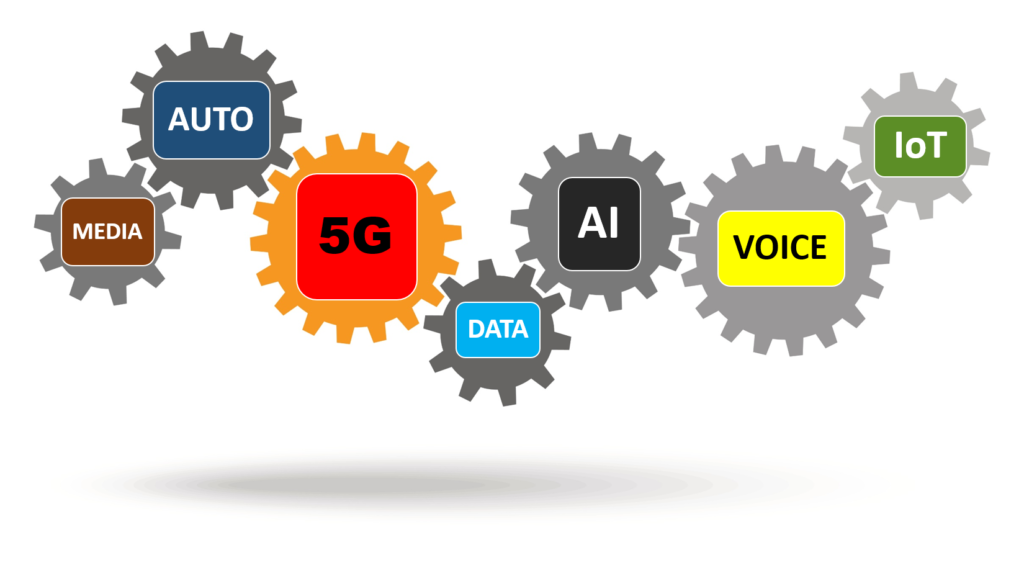
CES is becoming more about themes rather than gadgetry. And understanding how they impact radio broadcasting was a task not lost on the executives we toured around the LVCC last week.
There are a raft of them, but these five themes have been on my mind these past few days:
1.Voice was all over virtually every exhibit at CES like smartphones once were. And once again, the action was dominated by Google and Amazon. Apple was a no-show as they always are at CES, with virtually no buzz for their HomePod. Bixby had more presence at CES than our old friend, Siri.
 But if you’re of the mind that only one of these “voices” will be around five years from now, you have to hand it to Google once again. Readers of this blog know last year’s all-out assault by Google literally dominated Amazon’s modest display. This year, Google one-upped themselves – or maybe it was five-upped.
But if you’re of the mind that only one of these “voices” will be around five years from now, you have to hand it to Google once again. Readers of this blog know last year’s all-out assault by Google literally dominated Amazon’s modest display. This year, Google one-upped themselves – or maybe it was five-upped.
Their massive exhibit was bigger, better located, more spacious, and manned by a battalion of enthusiastic street teamers, seemingly numbering in the hundreds. And inside, there was a theme park ride, complete with two-person cars that resembled Disney’s “It’s Small World” on steroids.
But voice has moved well beyond smart speakers sitting on kitchen islands and nightstands. Everywhere you journeyed at CES, you saw “Alexa” and “Hey, Google” voice technology baked into thousands of devices, gadgets, and appliances.
We wil get an update very soon in Techsurvey about how many Echo and Google Home smart speakers are now owned by radio listeners. But the bigger story is how voice is becoming a platform that’s rapidly replacing typed or texted “search” as we’ve known it for the past couple decades.
2. The car continues to be a big CES trend, but not always in the form of dashboard apps. Automotive is changing – but not just because of autonomous, electrification, and smart cities. The invasion of voice in the car started years ago, but is now ramping up quickly. Last Thursday in a post called “Who’s Got The Best Voice?” we showed you a new Mustang muscle car with no fewer than four different voices embedded for the driver and passenger, making it convenient for just about anyone wishing to make things happen by simply articulating it.
It wasn’t lost on any of our radio executives that Amazon moved its exhibit from the parking lot to North Hall – the home of all things automotive 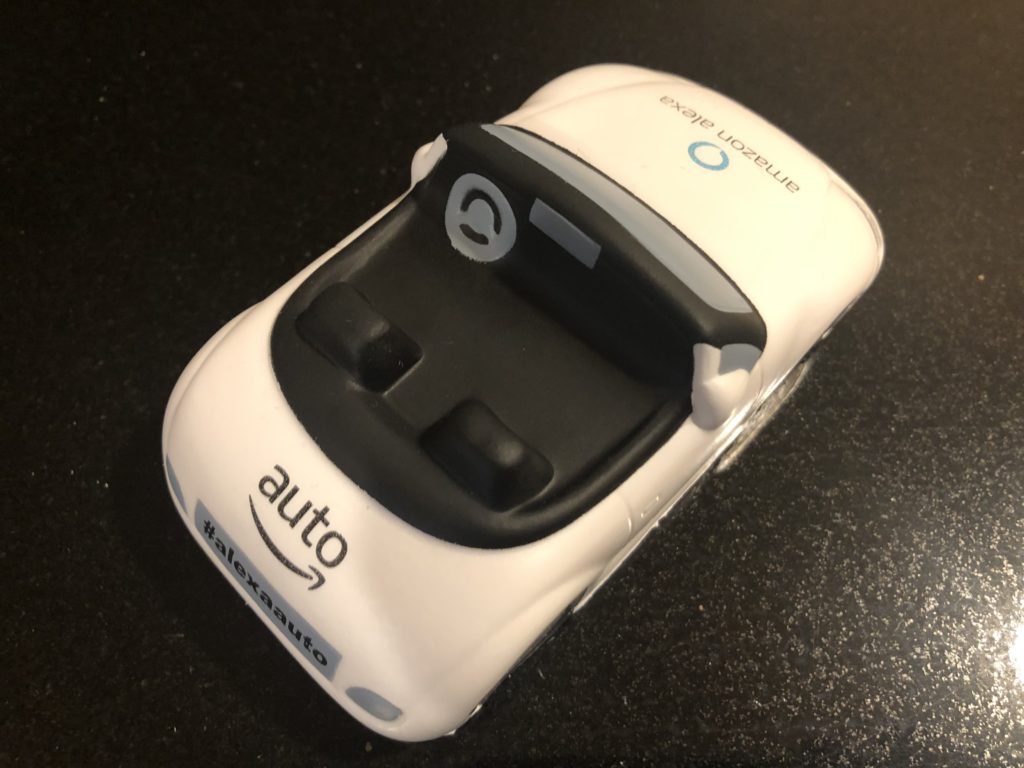 at CES. And perhaps the most impressive car we saw at CES was the one pictured at right. It’s made of foam and only weighs two ounces, but it made a tectonic statement about Amazon’s intentions with Alexa.
at CES. And perhaps the most impressive car we saw at CES was the one pictured at right. It’s made of foam and only weighs two ounces, but it made a tectonic statement about Amazon’s intentions with Alexa.
While Alexa is making its way through many car makers with the same speed Apple CarPlay and Android Auto did a few years back, their Echo Auto is essentially an after-market product that can enable Alexa in just about any vehicle.
That’s right – with Echo Auto, it’s now possible to bark out commands to Alexa in a 2005 Subaru Forester or 2012 Dodge Caravan with a simple device that retails for just $50, but is now being discounted for half that price.
Here’s the kicker: Amazon has already received more than a million preorders for Echo Auto – a sure sign many drivers want the company of Alexa on their commutes. These drivers will gravitate away from the friendly pushbutton and presets to find their favorite radio station, making the car a whole new challenge for broadcasters.
3. Partnerships continue to play a growing role at CES, as companies, organizations, and innovators realize the power and practicality of joining forces.
 Over at the Bellagio, GENIVI Alliance – a global consortium of automakers, suppliers, and others involved in one of the world’s most important industries threw their annual shindig – a reception attended by more than 1,000 enthusiasts (a record). And once again this year, the NAB was a major player at this influential event with their “wall of radio” – a bigger than life display that filled the room with music, while showing off how album art and smart displays can make car dashboards look even better.
Over at the Bellagio, GENIVI Alliance – a global consortium of automakers, suppliers, and others involved in one of the world’s most important industries threw their annual shindig – a reception attended by more than 1,000 enthusiasts (a record). And once again this year, the NAB was a major player at this influential event with their “wall of radio” – a bigger than life display that filled the room with music, while showing off how album art and smart displays can make car dashboards look even better.
As part of its partner activities, NAB also brought music performance to the reception. Rock band Dorothy – fronted by the talented Dorothy Martin – performed a great acoustic set for the assembled members of the Alliance. It was another indicator of the industry’s growing presence at CES – an event where not long ago, broadcast radio was a virtual no-show.
Partnerships were everywhere you looked at CES. At the amazing LG exhibit, we watched Google jumpsuit-wearing street teamers demonstrating  devices equipped with “Hey, Google” voice technology – including Robert pictured here showing off how voice-enabled Google search makes the TV watching experience richer and more fun.
devices equipped with “Hey, Google” voice technology – including Robert pictured here showing off how voice-enabled Google search makes the TV watching experience richer and more fun.
In other areas of LG’s “city-state” of technology, Google staffers showed up audio headgear and other products where “Hey, Google” was the command that got things done. It was an impressive display of two major brands working together to further each other’s presence at CES.
4. “Hearables” are quietly becoming another audio trend, and they were on display at CES. If you’ve used Apple’s Air Pods in the past couple years, you know how these little devices plugged into your ears are becoming an important conduit to content. Hearables – or smart headphones – now enable users to connect with voice assistants, enabling content access while people are on the go (which is pretty much all the time).
Paul and I had our annual breakfast in Las Vegas with our “CES north star,” Jerry Lee. This was Jerry’s 52nd consecutive show. I spoke with a number of CTA employees who tell me Jerry may be in a class all his own when it comes to CES attendance. I asked Jerry a number of years ago why he wouldn’t think of missing CES, and he explained to me, “I don’t want to miss the future.”
And sure enough, the moment we sat down at Lucky’s to scarf down a little breakfast before a full day of touring at CES, Jerry whipped out a pair of 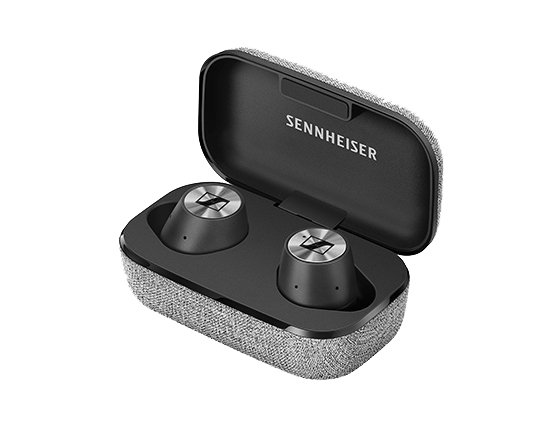 hearables, Sennheiser’s premium product – called Momentum (pictured right). Many of you engineers and air talent know the Sennheiser name from their quality mics and headphones. And now they’re moving headlong into the hearables arena.
hearables, Sennheiser’s premium product – called Momentum (pictured right). Many of you engineers and air talent know the Sennheiser name from their quality mics and headphones. And now they’re moving headlong into the hearables arena.
The same trend struck Nielsen’s Brad Kelly who was enamored by MEE audio’s EarBoost, adaptive audio enhancement earbuds that include the ability to EQ the music on your smartphone.
Look for hearables that can do more and more to show up all over the place in the next year or two. And the good news is they’ll get us used to wearing hearing aids when that day comes.
5. Boot-strapping continues to get bigger at CES. And that means Eureka Park, the side-show at the Sands Convention Center comprised of swashbucklers, mavericks, innovators, and crackpots committed to inventing “the next big thing.”
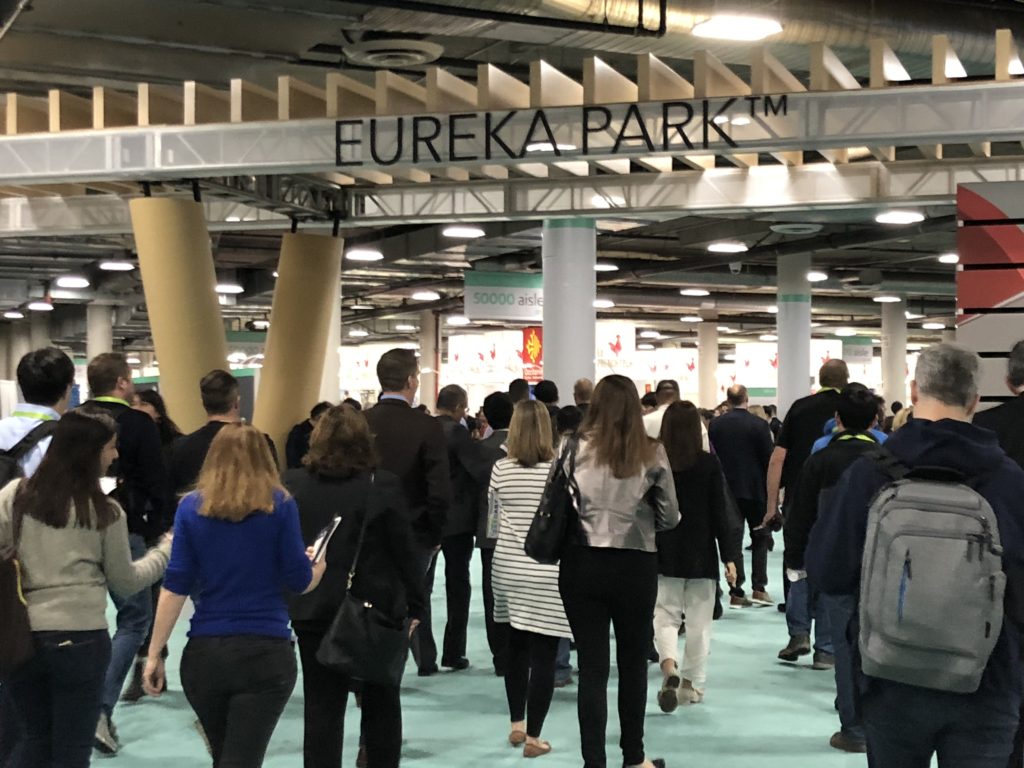 This year, more than 1,100 exhibitors enthusiastically showed their wares at Eureka Park, and we spent the better part of the afternoon walking through this amazing techie flea market. I spoke with numberous broadcasters on our tour who also took the time to hang out at the Sands, and to a person, they enjoyed the experience immensely.
This year, more than 1,100 exhibitors enthusiastically showed their wares at Eureka Park, and we spent the better part of the afternoon walking through this amazing techie flea market. I spoke with numberous broadcasters on our tour who also took the time to hang out at the Sands, and to a person, they enjoyed the experience immensely.
Eureka Park is symbolic of a larger trend that even the little guy – or gal – can change the world with an incredible invention in a world where the barriers to entry continue to diminish.
Notably, Beasley Media Group developed a hackathon with the University of Nevada Las Vegas. Several teams formed to work on developing a breakout innovation. And right in the heart of Eureka Park, awards were given out Thursday afternoon to a young UNLV team of all freshmen. It underscored the growing importance of youthful enthusiasm to the innovation process.
So, please don’t ask me about the hottest new toy at CES because I’ll bend your ear talking about some of these mega-trends and other revolutions that will one day rock our personal and business worlds.
For our Jacobs CES tour attendees, it didn’t take long for them to better understand that broadcast radio is a small cog in the massive media and  technology machine. And the clock is ticking.
technology machine. And the clock is ticking.
Katz’s Scott Porretti told me that radio “needs to move even faster and with more rigor, as we still have a huge opportunity in front us in this changing world.”
True that, but it starts with understanding radio’s place in the tech/media ecosphere. And at CES, it hits you at Mach 5 speed.
But if we learn from that big world of innovation, objectively look at our challenges and opportunities, form partnerships where we can, and connect a few key dots, we can ensure broadcast radio will have a bright future amidst all this change and disruption.
That’s what CES is truly all about.
And for radio broadcasters, that’s “the next big thing.”
CES 2019 on the Inside Radio Podcast
Paul Heine, the Managing Editor of Inside Radio, invited me on his podcast to talk about this year’s CES:
[coolcastplayer id=”72″]
- What To Do If Your Radio Station Goes Through A Midlife Crisis - April 25, 2025
- A 2020 Lesson?It Could All Be Gone In A Flash - April 24, 2025
- How AI Can Give Radio Personalities More…PERSONALITY - April 23, 2025




Well done!
Hey, I’ve been going 10 years – it should be pretty good by now. Seriously, thanks!
Thank you Fred for your very thoughtful look into CES each year. I love your perspective & enjoy the feeling you convey that you are carrying us radio folkes (geeks) on your shoulder as you explore the show. I love your inclusion of old friend Jerry Lee on your travels. See you soon.
John, appreciate these comments. Paul and I love taking radio to CES. It’s constructive, eye-opening, and yes, fun. Hope all’s well in your expanding world.
Sennheiser’s Momentum looks amazing. Thank you for the article Fred!